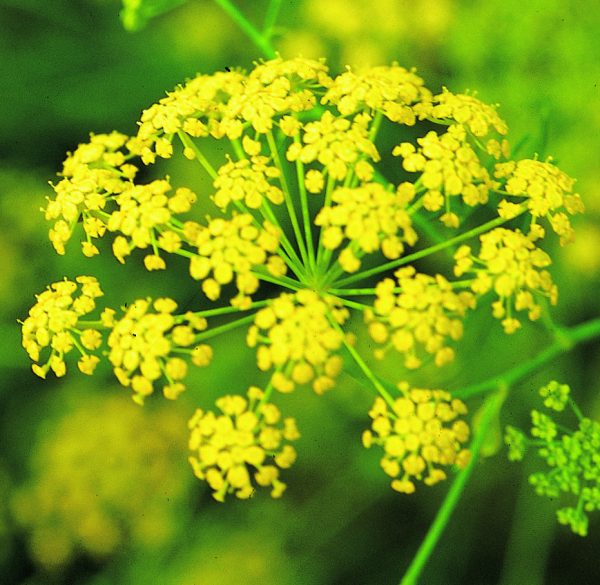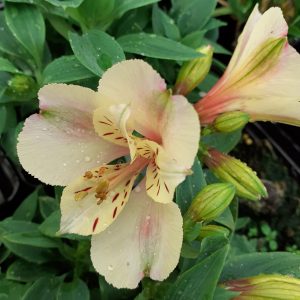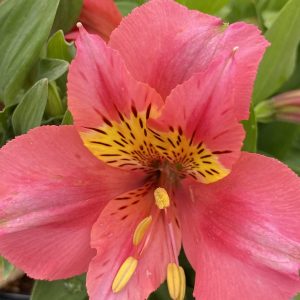Anethum graveolens ‘Vierling’
£6.45
Dill. Aromatic annual with strong stems and finely cut blue-green foliage. Flat umbels of deep yellow flowers in summer. Leaves are invaluable for cooking, its flowers and seeds for salads and as a cut flower. Will self-sow freely. Height 90cm. Spread 40cm. Full sun. Well-drained soil.
Description
Anethum graveolens ‘Vierling’ is a fragrant and versatile herb that adds flavour and greenery to your garden. Known for its aromatic leaves and seeds, it thrives in well-drained soil and sunny locations. Here’s an in-depth guide on planting established rootball plants to ensure a healthy and vibrant crop of dill in your garden.
PLANTING and AFTERCARE GUIDE
Best Planting Time
- Spring: The ideal time to plant your established Anethum graveolens ‘Vierling’ is during spring when the soil has warmed. This gives the plant time to settle and establish its roots before the warmer months, promoting healthy growth and a bountiful harvest.
- Autumn: You can also plant in early autumn, which gives the herb time to develop roots before the cooler months arrive. This helps the plant come back strong when the temperatures rise again in spring.
Site Selection
- Sunlight: Anethum graveolens ‘Vierling’ thrives in full sun. Choose a site that receives at least 6 hours of direct sunlight each day. The sunlight helps the plant grow tall and produce abundant aromatic leaves and seeds.
- Soil: Ensure the soil is well-drained for Anethum graveolens ‘Vierling’. The plant dislikes waterlogged conditions, so amend the soil with compost or organic matter to improve drainage and fertility. The soil should be light and slightly sandy, allowing for deep root penetration.
Planting Instructions
- Prepare the Hole: When planting your established Anethum graveolens ‘Vierling’, dig a hole that is approximately twice the size of the rootball. This gives the roots plenty of room to spread and establish themselves comfortably.
- Soil Preparation: Before planting, mix compost or organic matter into the soil to enhance its structure and fertility. Anethum graveolens ‘Vierling’ thrives in nutrient-rich soil, so this step is crucial for strong growth and abundant harvests.
- Planting: Place the rootball of your Anethum graveolens ‘Vierling’ into the prepared hole, ensuring that the top of the rootball is level with the surrounding soil. Backfill the hole with soil and gently firm it down to remove air pockets. Be careful not to bury the plant too deeply, as this can restrict growth.
- Watering After Planting: Water thoroughly after planting to help settle the soil and encourage the roots to establish. Keep the soil moist but well-drained, as excessive moisture can lead to root rot. Anethum graveolens ‘Vierling’ prefers moist, not soggy, soil.
Watering Requirements
- Growing Season: Once established, Anethum graveolens ‘Vierling’ requires moderate watering. Keep the soil consistently moist, especially during dry spells, but avoid overwatering. Allow the soil to dry out slightly between waterings to prevent waterlogging.
- Dormant Season: During the dormant period in winter, reduce watering significantly. Only water the plant if the soil becomes overly dry, as Anethum graveolens ‘Vierling’ needs very little moisture while dormant.
Feeding
- Spring: At the start of the growing season, apply a light, balanced fertiliser to give your Anethum graveolens ‘Vierling’ a strong start. This encourages healthy foliage and supports root establishment.
- Mid-Summer: Consider a light feed with organic fertiliser in mid-summer to maintain vigour and promote continuous growth, especially if your Anethum graveolens ‘Vierling’ is in a container or nutrient-depleted soil.
Pruning
- Deadheading: To keep your Anethum graveolens ‘Vierling’ healthy and tidy, regularly remove any dead or damaged leaves. Pruning the plant encourages new growth and prevents the spread of disease.
- Autumn Care: After the growing season, you can cut back your Anethum graveolens ‘Vierling’ to the base. This helps prepare the plant for dormancy and supports healthy growth in the next season.
Mulching
- Spring Mulching: Applying a layer of mulch around the base of the plant in spring helps retain moisture, suppress weeds, and regulate the temperature of the soil. Use organic mulch like straw or wood chips for best results.
- Winter Protection: In winter, mulch around the plant to protect the roots from frost. This extra layer of protection ensures the herb survives the colder months and returns healthy in the spring.
Supporting the Plant
- Staking: Anethum graveolens ‘Vierling’ is typically a sturdy herb, but in areas with strong winds or in overly damp conditions, it may benefit from light staking to prevent the stems from bending or breaking.
Final Tips
Anethum graveolens ‘Vierling’ is a low-maintenance herb that thrives in sunny, well-drained locations. By following these simple planting and care guidelines, you can enjoy the aromatic leaves and seeds of this herb throughout the growing season. Regularly harvest its fragrant leaves for culinary use, and it will reward you with plenty of flavourful additions to your dishes. Enjoy the beauty and practicality of Anethum in your garden, and it will continue to thrive year after year!
Additional information
| Pot Size |
|---|











Reviews
There are no reviews yet.